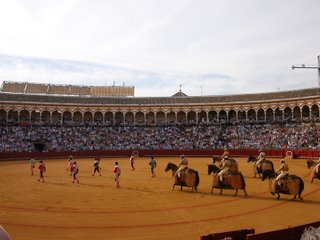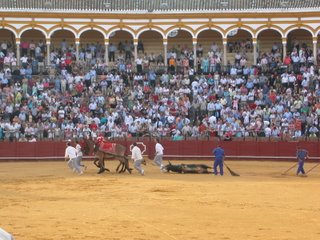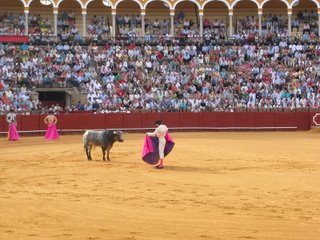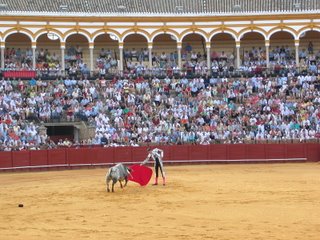
I’ve done about everything Spanish there is to be done in Spain by now, everything except the most stereotypically Spanish of all: a bullfight. Bullfights, like flamenco, fans, and Feria are a remnant of the old world, a subject of hot moral debate in modern times, and a practice that many Spaniards, including my señora, don’t support. In fact, Cataluñya, the north-east province that is home to Barcelona, is trying to ban bullfighting. Of course, they’re also trying to separate from Spain and use their native language calalán instead of castellano, what better way than to reject a Spanish tradition.
I had to go to a bullfight. I don’t condone the killing or torturing of bulls, horses, or the mauling of people in the bullring, but I had to go see it. From a moral standpoint, it was actually an interesting study in spectator sociology, because in the face of a 1,000 pound bull on the loose, the audience sympathizes with their fellow humans in the bullring, making it easier and almost a relief to see the bull finally die. I tried not to think about the moral implications of this, because whether or not I paid 10€ to sit in the sun at La Real Maestranza yesterday, six bulls would have died and the crowd would have cheered.

I ended up at a novillada or novice bullfight because the real corrida season is pretty much over. It was all the same to me because it was cheaper, less crowded, and a more than adequate taste of the bull aspect of Spanish culture. At almost every fight there are three toreros (or bullfighting novices in my case), and six bulls. The basic organization of the killing of each bull is the same, with the torero as boss and all of his little helpers running around doing their part. The bull is let out of the gate and he runs into the bullring to a chorus of “wows” from the audience and a song from the band. Novillada bulls are supposedly smaller than the real bulls used, but they are still huge, black, and fast, with big horns. All of the little helpers and the matador are out on the dirt with pink capes, running the bull around the ring to see what it’s like. Some of them were fast, some were stupid, and some were mad; the torero’s technique later depends, in part, on the bull’s mood and, in part, on how stupid, brave, or well-practiced the torero is. After they run him around and antagonize him a little bit, they parade a horse and rider with a spear onto the field. The horse is blindfolded, wearing a ridiculous-looking dress that’s horn-proof, and the rider has his feet in steel stirrups. Ideally the rider will stab the bull twice in the back with his spear, starting the process of spilling blood and weakening the bull. Then some of the helpers grab little, colorful spears and run straight at the bull, veering at the last second to stick them into the same spot on the bull’s back. At this point the bull ideally has eight colored sticks hanging out of his back, his red blood is visible on his black skin, and the torero steps out with his small, red cape and sword.

This is the subject of the common pictures of bullfights. The torero with his tight, heavily decorated suit stands with his red cape off to the side, twisting his body around as the bull runs at the cape. Ideally it’s a very calm process and the torero has the bull transfixed and his every move controlled by the red cape. Interestingly enough, bulls are actually colorblind, but they’re attracted to the movement of the cape as the torero stands still beside it. After tiring the bleeding bull out still more with a series of these passes, the torero will ideally stick his sword into the perfect spot on the bull’s back so it reaches his heart. The helpers come out and confuse him with their capes and the bull, exhausted and bleeding, falls within a few minutes. The torero holds up his arms to the audience’s applause and one of the helpers takes a knife and sticks it into the bull’s brain to finish him off for good. If the judge says the torero has done especially well, someone comes out and cuts the ears off the bull (and/or the tail), and gives them to the fighter.

During my particular fight no ears or tails were awarded and most of the swords weren’t stuck in at that perfect spot or far enough in, so the bulls had to walk around the ring suffering for awhile before they fell. The last bull fell eventually with the sword half hanging out of his back, but when the helper went in for the final kill, the bull jumped back up again. One of the bulls was so angry at the helpers antagonizing him with their capes from behind the wall that he made a run at the wall and broke a piece of molding, sending it high into the air. The last bull succeeded in running the horse and rider with the spear up against the wall and toppling them over, so while a team of eight men in berets and red polo shirts tried to get the horse on his feet again, the helpers tried to keep the bull’s mind off the completely powerless horse. They blindfold the horses because they would freak out if they saw a bull running at them, but the horse gets freaked out anyway and backs up even though he can’t see the bull. The last torero, from France, was actually crazy, and he met the bull at the gate. He got down on his knees facing the gate, and as the bull ran into the ring he flipped his cape up over his head so the bull ran around him instead of straight into him. This torero also put in all of the little spears in by himself, doing a little ballet with each set as the music cheered him on. He was cocky but the audience loved him as he ran around without a cape, pushing the bull away with his hands.
As you can probably tell, bullfights are a guy’s sport. Esteban went with his polo shirt and sunflower seeds, and I went like a Spanish woman, with makeup, high heels, and a skirt. And when it started getting boring or gory or the sun, heat, and flies got too intense, I pulled out my fan and started fanning myself impatiently. From the movement around the rest of the ring, it seemed that most women were doing the same. What would a traditional Spanish bullfight be without traditional Spanish machismo?


2 comments:
Sounds interesting...definately a cultural experience, though your description reminded me of Lord of the Flies.
Lindsey. You've poisoned your sister. Definitely. Definitely!
Your tales from Spain are marvelous.
Post a Comment